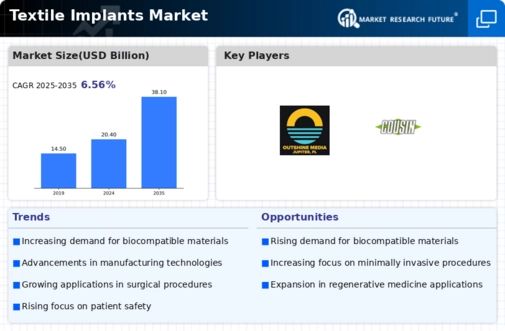Market Growth Projections
The Global Textile Implants Market Industry is projected to experience substantial growth over the next decade. By 2024, the market is expected to reach a valuation of 20.4 USD Billion, with further expansion anticipated as it approaches 38.1 USD Billion by 2035. This growth trajectory reflects a compound annual growth rate (CAGR) of 5.82% from 2025 to 2035. Various factors contribute to this upward trend, including technological advancements, increasing healthcare investments, and a rising prevalence of chronic diseases. The market's evolution is indicative of broader trends in healthcare, where innovative textile solutions are becoming integral to patient care.
Increasing Prevalence of Chronic Diseases
The Global Textile Implants Market Industry is significantly influenced by the rising prevalence of chronic diseases, such as diabetes and cardiovascular conditions. These diseases often necessitate surgical interventions, leading to a higher demand for textile implants used in procedures like vascular grafting and orthopedic repairs. As the global population ages and lifestyle-related health issues become more common, the need for effective medical solutions grows. This trend is expected to drive the market's expansion, as healthcare systems seek to provide better treatment options. Consequently, the Global Textile Implants Market Industry is poised for robust growth, with a projected CAGR of 5.82% from 2025 to 2035.
Rising Demand for Biocompatible Materials
The Global Textile Implants Market Industry experiences a notable surge in demand for biocompatible materials. This trend is primarily driven by advancements in medical technology and an increasing focus on patient safety. Biocompatible textiles, which minimize adverse reactions in the human body, are becoming essential in various applications, including surgical implants and wound dressings. As healthcare providers prioritize patient outcomes, the adoption of these materials is likely to rise. The market for biocompatible textiles is projected to contribute significantly to the overall growth of the Global Textile Implants Market Industry, which is expected to reach 20.4 USD Billion in 2024.
Growing Investment in Healthcare Infrastructure
Investment in healthcare infrastructure is a critical driver of the Global Textile Implants Market Industry. Governments and private entities are increasingly allocating resources to enhance healthcare facilities, particularly in emerging economies. This investment not only improves access to medical services but also fosters the adoption of advanced medical technologies, including textile implants. Enhanced healthcare infrastructure facilitates the integration of innovative textile solutions into clinical practice, thereby expanding the market's reach. As a result, the Global Textile Implants Market Industry is likely to benefit from these developments, contributing to its anticipated growth trajectory in the coming years.
Rising Awareness of Advanced Wound Care Solutions
The Global Textile Implants Market Industry is witnessing a growing awareness of advanced wound care solutions among healthcare professionals and patients. The shift towards more effective and efficient wound management strategies is prompting the adoption of specialized textile implants designed for wound healing. These textiles often incorporate antimicrobial properties and moisture management features, which enhance healing outcomes. As healthcare providers increasingly recognize the benefits of advanced wound care, the demand for these innovative solutions is expected to rise. This trend is likely to bolster the Global Textile Implants Market Industry, aligning with the overall growth projections for the sector.
Technological Advancements in Textile Engineering
Technological innovations in textile engineering are transforming the Global Textile Implants Market Industry. Enhanced manufacturing processes, such as 3D weaving and bioengineering, allow for the creation of complex textile structures that can meet specific medical requirements. These advancements enable the production of textiles that are not only functional but also tailored to individual patient needs. As a result, the market is witnessing an influx of innovative products that improve surgical outcomes and recovery times. The integration of smart textiles, which can monitor physiological parameters, further exemplifies this trend. Such developments are likely to propel the Global Textile Implants Market Industry towards a valuation of 38.1 USD Billion by 2035.












